Voice Search Optimization to Improve Customer Experience
Shape your website to give the best of both worlds

Reading Time: 8 minutes
People are becoming busier, they have less free time, are surrounded by work and other commitments, and are trying to catch up with the world’s fast pace of living!
40.2% of the US population is expected to use voice search features in 2022.
Given its convenience, this number is only going to rise.
For businesses representing themselves online, it’s crucial to meet the needs of their customers to reach and/or remain on top, gain stable traffic, increase sales, and promote their products. So, it’s important to take optimizing for voice search seriously.
In this article, we’ll show you how voice search works, what customers search for when using this feature, and how you can catch up by optimizing your site.
How Does Voice Search Work?
Voice search is a technology that enables consumers to look for information, products, etc., using their voice. The algorithm behind this tech involves machine learning. It transcribes your voice into text, matching the query to the most relevant results online.
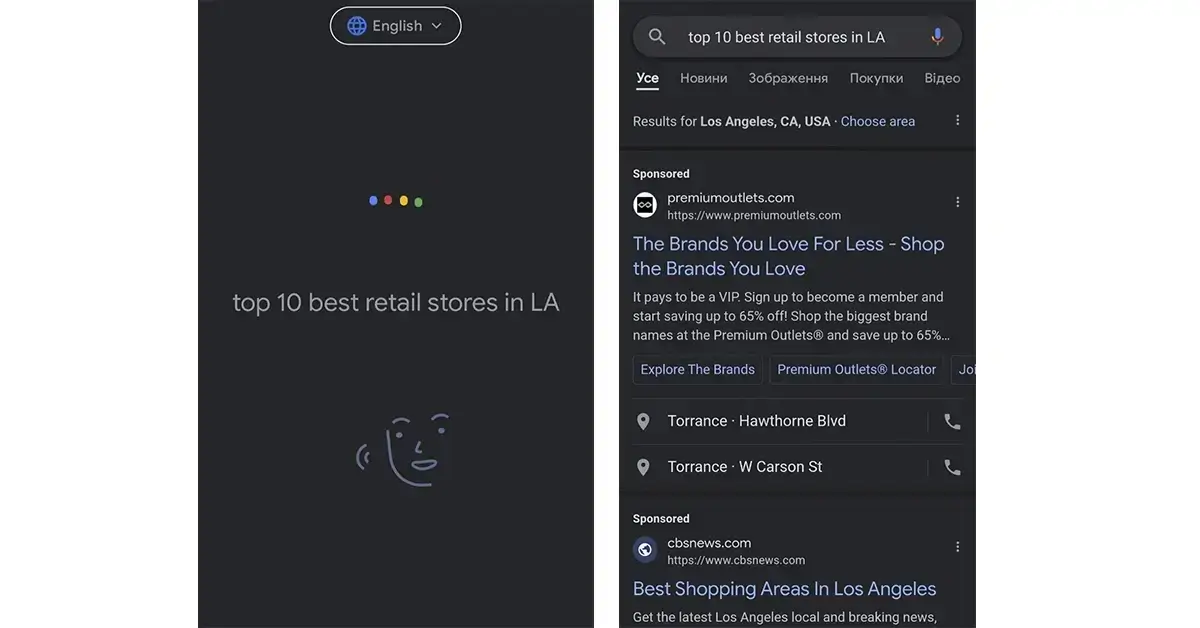
Here’s an example:
- You search for “top-10 best retail stores in LA”.
- The machine listens to your command and transcribes it.
- It scans the words for questions, commands, and queries.
- The recognized commands are put through an external search (search engine; Google, for example).
- The best-featured result is chosen and translated back to voice, or the phone does the command you provided.
This may seem complicated, but for us humans, it’s a quick, easy, and convenient way to find information without typing or even putting our phones into our hands. If you have a voice assistant, the phone isn’t even needed.
What Are People Searching for When Using Voice Search?
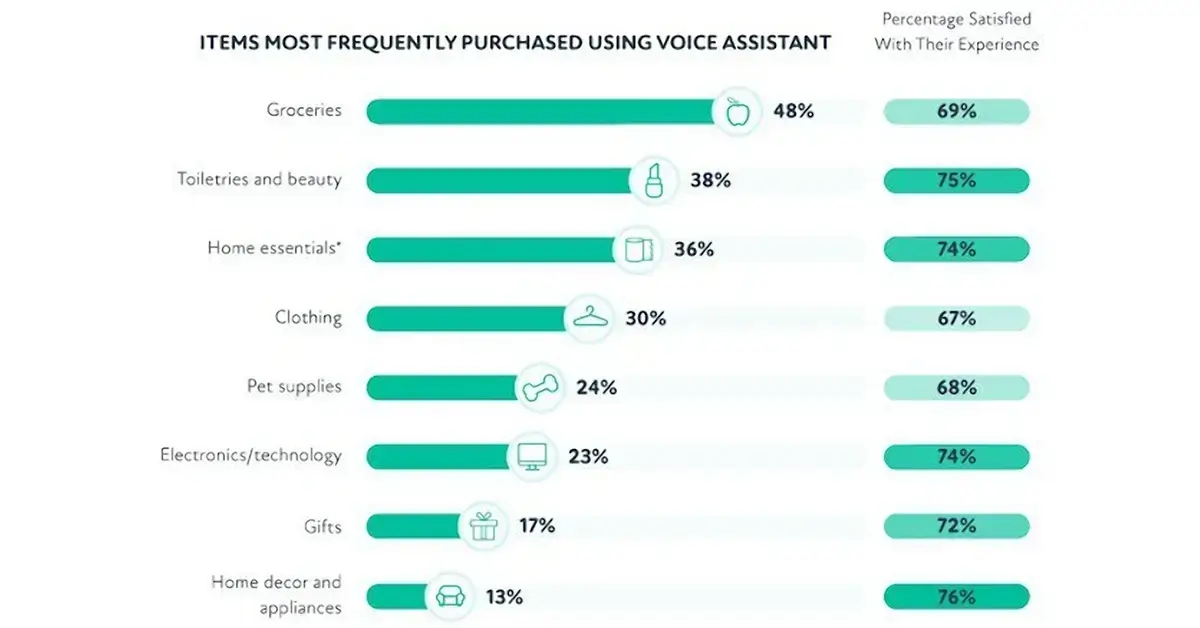
When it comes to shopping, for example, 48% of people look for groceries, but many also search for home essentials, beauty products, clothing, pet products, electronics, and gifts using voice shopping.
Consumers also look for local businesses to buy from or for a certain product or service. They research products, compare them and do background checks on businesses to find out how to solve their problems efficiently.
This is aside from looking for directions, finding out the weather, playing music, and so on.
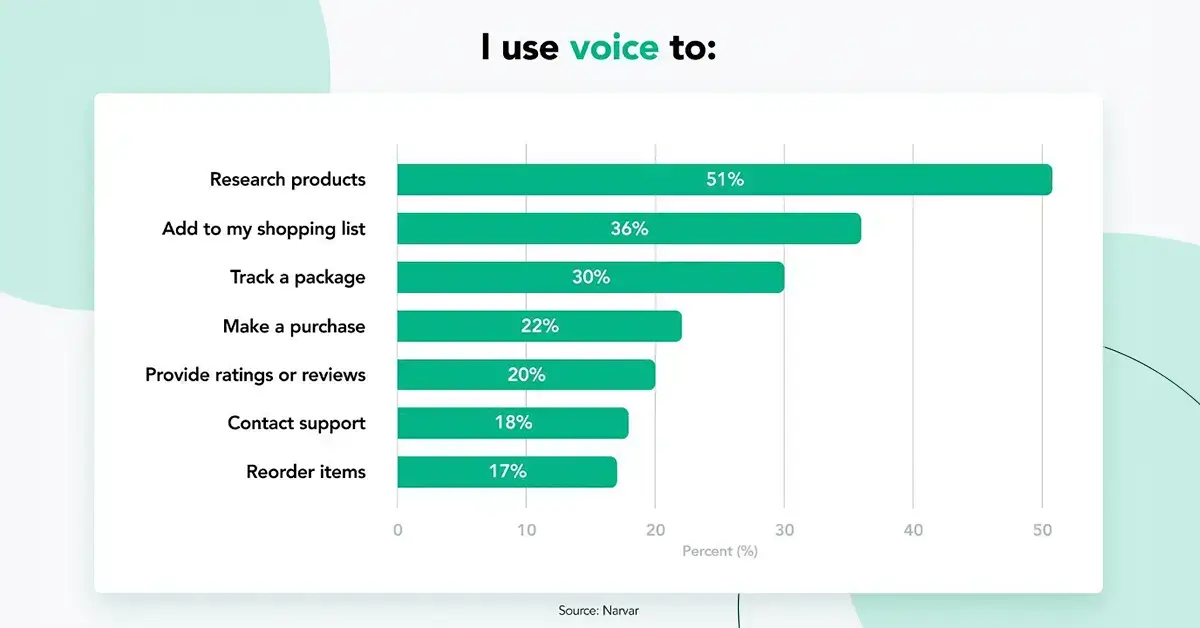
Another report by Narvar suggests that 51% of product-related searches are to research a product or service, while 36% are to add to the shopping list, and 22% – to make a purchase.
So, we can conclude that slightly over half of voice searches are connected to looking for or researching a certain product or service.
Why Does Voice Search Matter for Customer Experience?

Voice search shapes the way businesses interact with audiences.
First of all, more people will learn about your company, products, and services if you use voice search optimization practices. This is the most basic thing you can do regarding customer experience – help people find solutions to their problems.
Using voice also helps to build relationships and increase trust. Not to mention, the process becomes faster. Earlier, when email was the hottest trend, the response time was limited to several hours. Now, with voice search, you can provide an experience in real-time.
Vocal assistance for your customers is also more convenient than text. It makes it easier to find items and order them.
For example, if you have a retail store, you can optimize your E-commerce website not only for voice search but also for vocal functionality within the online store. Searching for products will become faster and easier, improving the brand experience and potentially increasing sales.
Ways to Prepare Your Website for the Voice Search Era
So, if this technology is so important, how to optimize for voice search?
There are several things you can do to pop up in your target audience’s voice search results.
Long-Tail Keywords for Voice Search Optimization
Keywords are the words and phrases that connect you to your target audience. The audience uses them in their searches to look for information, and you can use them to optimize your content and make it rank higher in, say, Google to appear first in search results.
Before you use any keywords you find fit, it’s best to research them using a keyword search volume tool like the one by SE Ranking.
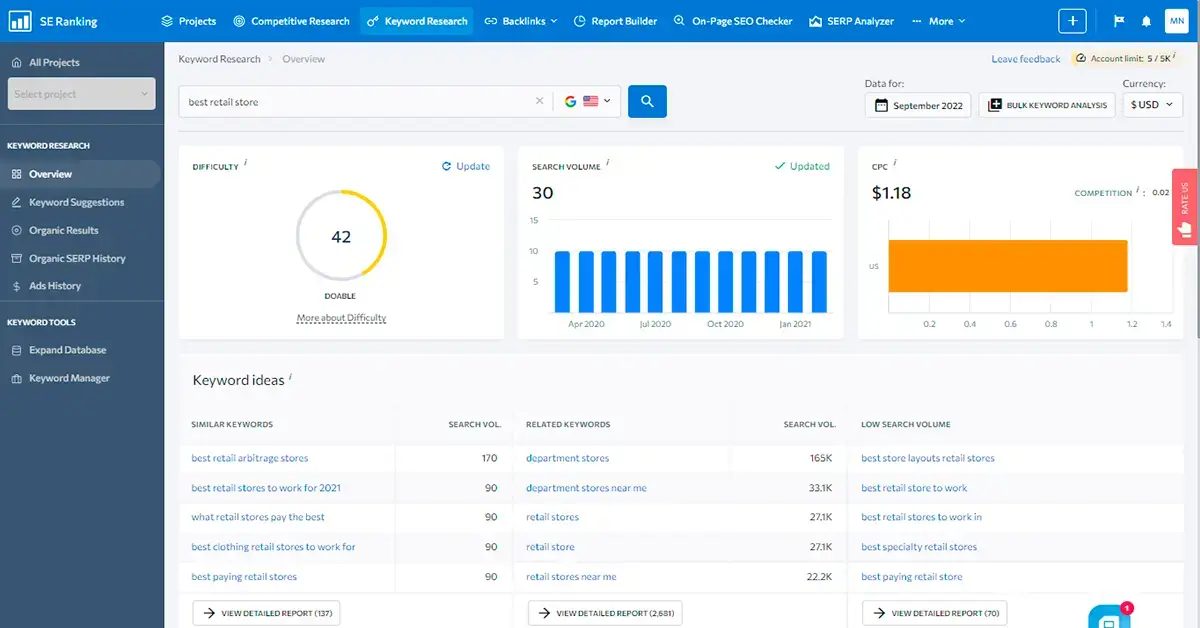
It’s a holistic keyword research tool that offers data on the query you research, including the number of searches per month for the keyword of your interest, its difficulty, and CPC. In addition, it offers suggestions of similar, related, and low search volume keywords that you could also include in your optimization strategy.
When you implement SEO voice search practices, the type of keyword you choose means a lot. We recommend using long-tail keywords for the task. They look more like questions and typically contain more than 2-3 words. When consumers use voice search, they don’t say “best retail stores NY”, they say something like “what are the best retail stores in New York?”.
The query looks like natural language, and a blog article such as “TOP-10 retail stores you have to visit in New York” should be on the results page to describe the store and highlight its benefits.
Business Listing Optimizing for Voice Search
All businesses that promote digitally know the importance of accurate information in business listings.
But what data should you provide there?
The name, address, phone number, and working hours?
Consumers are commonly looking for local businesses when using voice search, so you may as well add information on pricing, available items, promo codes, etc., to grab their attention. The main listing you use should depend on the search algorithm you’re optimizing for:
- Google – Google Business Account, formerly Google My Business
- Amazon – Yelp, Yext
- Apple – Apple Maps Connect, Yelp, review websites
A smart decision would be to use voice search optimization for all of those listings.
Content Optimizing for Voice Search
How to optimize content for voice search:
- Make scannable content with subheadings and lists.
- Make it readable without long sentences.
- Focus on smaller paragraphs.
- Use conversational language.
These are the easiest things you can do, even with existing content.
Also, your articles have to give direct answers to users’ questions. If a user asks, “What’s the best deal for Mazda 6 this year?”, the results should start with “The best deal for…” and numbers instead of a lengthy intro into the topic and several vague sentences.
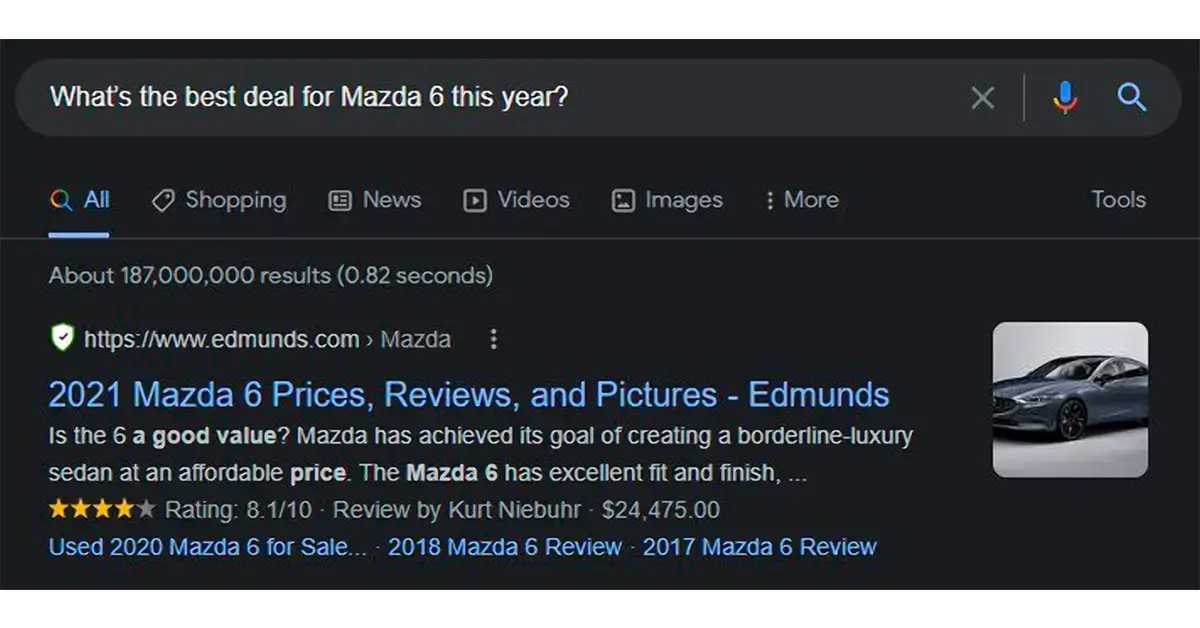
Here we have an example of an article that starts with questions and a lengthy intro instead of a short answer. However, below you can see the price offer, which can give you an idea of the best deal.
Featured Snippets Voice Search Optimization
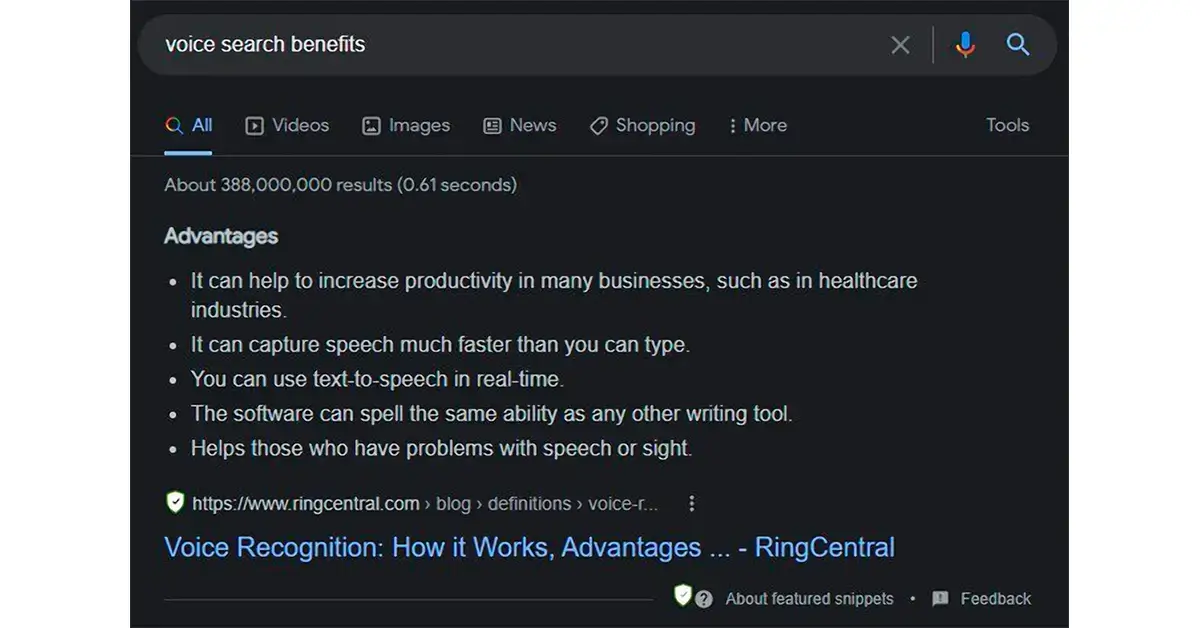
Featured snippets are also called Zero Results. They are the short answers to searchers’ questions that appear before the first organic result.
If you manage to get featured, your page will be number one in that SERP, even if you’re still fighting for the first organic ranking for the focus keyword.
Smartphones and smart speakers recognize these snippets and read them out loud to users, which brings your content, expertise, and brand right to the audience’s ears.
To provide your audience with responses in audio, make sure to add schema markup. Google’s Speakable, a voice support schema, should help you translate text to voice and reply directly to your potential buyers or clients.
Mobile-Friendly Website
58.99% of worldwide website traffic comes from mobile devices, excluding tablets. So, if your website isn’t mobile-friendly, you may lose around 60% of your visitors.
Besides, when you’re on the go, it’s more convenient to use voice search on your smartphone by just saying “OK, Google” rather than taking out your laptop, right? Furthermore, Google Mobile First indexing implies that if your site is optimized for mobile, you will appear in rankings much faster.
Make sure your pages load fast on smartphones and that the website has a responsive design, meaning it adapts the layout, text size, etc., to make it possible to navigate the source from a device smaller than your PC.
For example, Threadless makes an excellent first impression on both desktop and mobile versions of its website.

The desktop version shows neat navigation and Search feature, along with a cart, updates button, etc. at the top. The website loads very fast. As you make the window smaller, the navigation moves under the burger menu (three lines in the corner of the website), which you can also see in the lightning-fast mobile version.

Typeform, a Barcelona-based tech company, has another example of a website that meets expectations. The goal here is to simplify the website design, still leaving it stylish, making it load quickly, and offering a decent user experience.

Here is the Typeform mobile version.

Local Search Intent
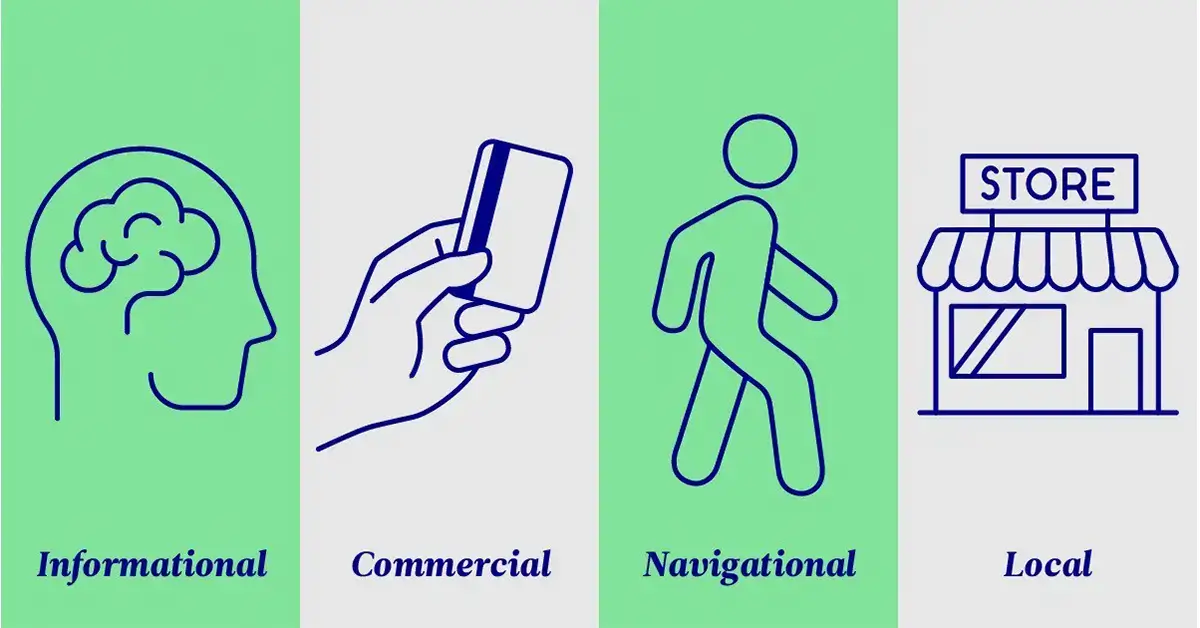
As voice search is often used to find local businesses, you can benefit from optimizing for keywords with local search intent. These include
- Queries with “near me” or location specification
- Train station names, hotel names, etc., in a specific city
- The name of the store with “opening times”, etc.
When consumers use such keywords, they want results that are geographically relevant to them. This is your direct target audience if they are looking for a store or service like yours in the location you’re in.
So, when researching keywords, always pay attention to the intent of your customers when looking for a page like yours.
To determine the search intent of your keyword, you can simply insert it in Google Search and review the TOP-10 results the search engine shows. By the answers those provide, you can see the intent Google established for the query.
Domain Authority Improvement
This point is important for all kinds of searches, not only voice search.
One of the ranking factors Google and other engines use when evaluating your site is its authority. A website with authority is more likely to rank higher and get featured snippets.
Here are some things you can do to improve the authority of your service or online store:
- Write valuable and relevant content – use statistics, conduct your own research, and provide expert information on industry topics.
- Build high-quality links – make sure to get backlinks from high-authority websites in your industry to be considered a credible source.
- Use SEO best practices – proper keywords, high-end customer experience, responsiveness, and the absence of technical errors all contribute to your authority.
Summarizing it
Optimizing for voice search is very important nowadays. More and more consumers are choosing to use their voices to look for facts, businesses, pricing, products, and services. There are several things you can do to keep up with the trend:
- Use long-tail keywords in your content.
- Optimize business listings with suitable keywords and provide more information there.
- Improve your content by simplifying it. Shorter sentences and paragraphs, lots of subheadings, and conversational language will all help.
- Add schema markup to your pages and aim for featured snippets to become the #1 result without having to do it in the main organic search.
- Improve the mobile-friendliness of your website.
- Keep local search intent in mind as people often use voice to look for local businesses.
- Improve Domain Authority to rank higher organically and be considered a credible source by search engines.
These approaches will help you reach your target audience and provide a seamless experience with your brand, products, and services.















